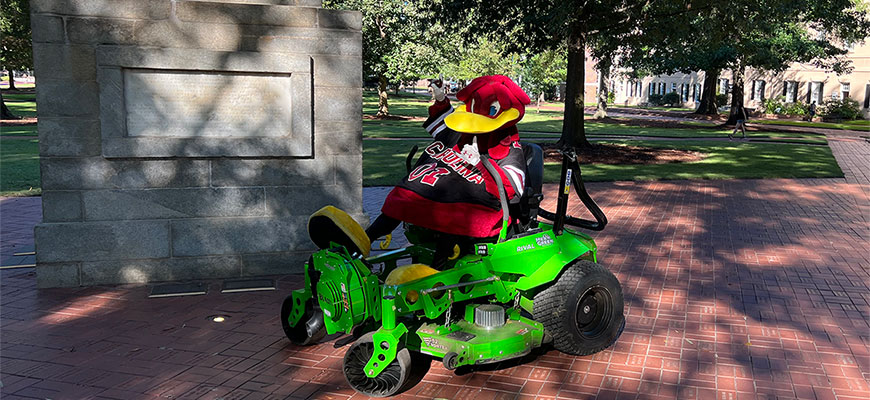Facility Services incorporates the principles of sustainability in our daily operations wherever possible. Some initiatives underway include:
- Transitioning our ground-keeping equipment from gas-powered to battery-powered. This reduces emissions and is much quieter on campus!
- Transitioning towards a more electrified fleet. Facility Services has both hybrid and fully electric vehicles and is continuing to convert our fleet.
- Redesign of our pesticide program to use more environmentally-friendly chemicals and reducing nearly by half the quantity and frequency of application.
- Installation of water bottle filing stations - both inside and outside of buildings
- Switching to a four-chemical cleaning system for routine custodial efforts, eliminating nearly 25 other cleaning chemicals from our inventory. This system also significantly reduces the plastic waste that is generated when pre-mixed chemicals are used.
- Implementing paper towel and hand soap dispensing systems that are both more sustainable and produce nearly 30% less waste.
- Caring for our urban forest. Facility Services manages the health of over 10,000 trees on the Columbia campus with our in-house arborist and using a comprehensive management software called ArborPro. We are proudly certified as a Tree Campus by the Arbor Day Foundation.Virtually eliminated the use of fuel oil for steam production, having obtained a stable and non-curtailable supply of natural gas. Combustion of natural gas emits about 30 percent less than fuel oil, as well as far fewer pollutants per unit of energy delivered.
In 2022, Facilities embarked on the Green and Garnet Initiative, where we are systematically examining buildings and making improvements for energy efficiency and occupant comfort. Phase one, expected to be completed in 2025, includes five of the largest energy consuming buildings on campus: Thomas Cooper Library, 1600 Hampton, Swearingen, Close-Hipp and Jones Physical Science.
Facility Services is also actively engaged in converting building lighting from incandescent lighting to LED lighting. We are committed to doing so in the most environmentally-feasible method possible, which often includes reusing the existing light fixtures and retrofitting them to become LED systems. Thomas Cooper Library and Calcott are two examples of recent conversion efforts, with many more on the horizon!
Working with CarbonSense, an innovative technology is being implemented and tested which uses existing building sensors to detect the volume of building occupancy and predict the needs of building occupants and to adjust the HVAC systems accordingly, using automated intelligence and machine learning. This technology allows for optimization of energy use while also ensuring that the building is heated and cooled at the right times and in accordance with occupancy patterns.
Did you know that Facility Services collects recyclable materials from every building on campus and sorts that at our very own Material Reclamation Facility (MRF)? In USC buildings, waste is collected in black trash bags and recyclable materials is collected in transparent bags. These bags are collected separately by our Waste and Recycling Services team members. Waste is transported to the municipal landfill, and all recyclable materials are transported to our MRF to be sorted for delivery to the appropriate industrial recyclable receivers.
In 2024, we reclaimed and diverted nearly 1.4 million pounds of recyclable materials from entering our landfills, including:
- 557,193 lbs of cardboard (OCC)
- 240,620 lbs of paper
- 211,760 lbs of e-waste
- 166,020 lbs of wood
- 98,040 lbs of books
- 50,520 lbs of scrap metal
- 32,320 lbs of plastic
- 18,620 lbs of glass
- 17,260 lbs of aluminum
- 7,796 lbs of light bulbs
All new construction and major renovations are required to be designed to comply with the South Carolina Energy Independence Act of 2007. This act requires that all major facilities projects be designed and constructed to achieve at least LEED Silver certification from the US Green Building Council or at least two globes certification using the Green Building Initiative’s Green Globes rating system.
Additionally, SC Code § 6-10-3 provides the South Carolina Energy Standards Act of 2009, as modified by 2012 Act 143, which requires that all buildings be designed and constructed in compliance with the 2009 International Energy Conservation Code.
